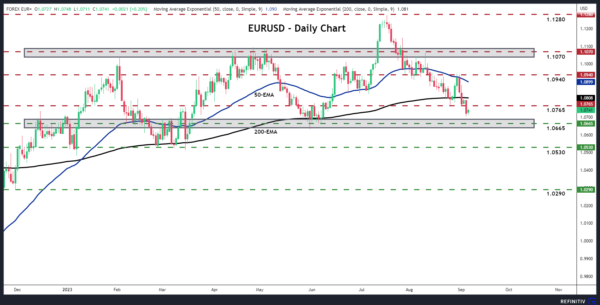With economic numbers out of the Eurozone heightening recession concerns, and US data keep pointing to a superior US economy, the euro/dollar pair has been in a sliding mode recently.
ECB seen holding its fire next week
At the last ECB meeting, policymakers raised interest rates by a quarter point, but they did not commit to further moves, with President Lagarde replying with a “decisive maybe” when asked whether they are planning to hike again in September.
The fact that Lagarde sounded less hawkish than anticipated combined with a streak of data pointing to continued economic weakness made investors skeptical as to whether officials should raise rates again at next week’s gathering. Even after the preliminary CPI data for August revealed somewhat stickier-than-expected inflation, investors are assigning only a 30% probability for a hike.
However, with core inflation still resting well above the 2% target, no one can conclude that the Bank’s mission has been accomplished. And yet, traders are seeing only a 60% chance for another hike later this year, which probably means that they are more concerned about economic performance than high inflation at this stage.
Markets expect the Fed to stand pat as well
A September hike is not expected by the Fed either. After the last decision, where Powell signaled data dependency, investors became convinced that the Fed will also take the sidelines in September, with Powell’s Jackson Hole speech only raising the probability for a hike by November. This allowed the dollar to continue drifting north, whose engines were already receiving fuel due to concerns surrounding the performance of the Chinese economy.
Last week though, investors had second thoughts regarding the probability of another Fed hike as a streak of US data, including Friday’s employment report, pointed to a cooling US labor market. And still, the US dollar held strong against its European counterpart, confirming that apart from monetary policy developments, traders are increasingly paying attention to economic growth divergences as well. Taking that into account, heading into the September policy decisions, euro/dollar may be poised to continue drifting lower.
But language and signals could be key
Nonetheless, whether this will develop into a bigger downtrend that will extend beyond September is not crystal clear yet and what could clear the fog may be the ECB and Fed decisions on September 14 and 20, respectively.
Recent remarks by ECB officials and very high inflation in the Eurozone suggest that the ECB is very likely to leave the door to further hikes open next week, and if officials sound hawkish enough, the euro could rebound, even if no interest rate increase is delivered at that meeting.
But this could last for less than a week if the Fed appears equally hawkish on September 20, signaling that they are not done raising rates either. Yes, inflation in the US is lower than in the Euro area, but it is also above the 2% target, with the August PMIs pointing to rising input costs. Ergo, a hawkish Fed could keep any ECB-related gains in euro/dollar limited and bring the currency pair back under selling interest.
A break below 1.0665 could complete the reversal
Technically, the move that could confirm a bearish reversal may be a decisive break below the 1.0665 territory, which offered strong support during June. Such a dip would signal a lower low on bigger timeframes, initially targeting the 1.0530 area, the break of which could see scope for extensions all the way down to the low of November 30 at 1.0230.
For the pair to return in an uptrend mode, a break above 1.1070 may be needed, and this could become possible if the ECB ends up appearing more hawkish than the Fed.















